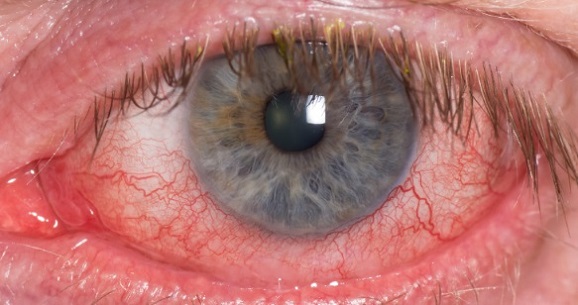Naringin Protects Retinal Cells from Damage and Prevents Vision Loss in Branch Retinal Vein Occlusion
Nikhil Prasad Fact checked by:Thailand Medical News Team Feb 20, 2025 1 month, 3 weeks, 1 day, 3 hours, 36 minutes ago
Medical News: Researchers Explore Natural Compound for Eye Health
A team of scientists from the College of Chinese Herbal Medicine at Beijing University of Chinese Medicine has uncovered promising results in their latest study on the use of naringin, a phytochemical found in citrus fruits such as oranges, lemons and grapefruit, as a potential treatment for retinal diseases. Their research focused on the ability of naringin to protect retinal pigment epithelial (RPE) cells from damage caused by hypoxia, a condition where cells are deprived of oxygen, which is a key factor in branch retinal vein occlusion (BRVO). BRVO is one of the leading causes of vision loss, and current treatments remain limited.
 Naringin Protects Retinal Cells from Damage and Prevents Vision Loss in Branch Retinal Vein Occlusion
Naringin Protects Retinal Cells from Damage and Prevents Vision Loss in Branch Retinal Vein Occlusion
This
Medical News report delves into the findings, revealing how naringin can counteract cell damage and reduce the risk of severe vision impairment. The study explored how this natural compound works at a molecular level to prevent ferroptosis, a specific type of cell death driven by oxidative stress. The results suggest that naringin may play a crucial role in protecting eye health and preventing blindness in individuals with BRVO.
The Threat of BRVO and the Role of Ferroptosis
BRVO occurs when one of the small veins in the retina becomes blocked, leading to reduced blood flow, oxygen deprivation, and subsequent damage to the retinal cells. This can cause inflammation, swelling, and the abnormal growth of new blood vessels, all of which contribute to vision loss. Scientists have identified ferroptosis as a major factor in BRVO-related cell damage. Unlike other forms of cell death, ferroptosis is triggered by an excess of reactive oxygen species (ROS) and lipid peroxidation, making it particularly destructive to cells.
Previous research has shown that hypoxia can significantly increase oxidative stress, leading to the overproduction of harmful ROS and lipid peroxides. This disrupts the antioxidant defense system, making cells more vulnerable to ferroptosis. The current study aimed to investigate whether naringin could counteract these harmful effects by strengthening the natural defenses of RPE cells.
Key Findings of the Study
The study used human RPE cells treated with cobalt chloride (CoCl2) to mimic hypoxic conditions. Researchers observed that exposure to CoCl2 led to a significant increase in oxidative stress and ferroptosis markers. However, when the cells were pretreated with naringin, several protective effects were noted:
-Reduction in Oxidative Stress: Naringin significantly lowered ROS levels and prevented lipid peroxidation, suggesting that it can combat the damaging effects of oxidative stress in RPE cells.
-Enhanced Cell Survival: The flavonoid improved cell viability by restoring the balance of key antioxidants, such as glutathione (GSH) and superoxide dismutase (SOD), which are essential for cellular defen
se.
-Suppression of Inflammatory Factors: Researchers found that naringin reduced the levels of inflammatory cytokines, including IL-6, IL-1β, and TNF-α, which play a role in disease progression.
-Inhibition of Ferroptosis Pathways: The study demonstrated that naringin activated protective proteins, including heme oxygenase-1 (HO-1) and glutathione peroxidase 4 (GPX4), which help prevent ferroptosis and maintain cell health.
-Prevention of Abnormal Blood Vessel Growth: Naringin was found to inhibit vascular endothelial growth factor (VEGF), a key protein involved in the formation of new blood vessels, which can lead to complications in BRVO patients.
These findings indicate that naringin has strong protective properties that could make it a valuable candidate for treating retinal diseases linked to hypoxia and ferroptosis.
The Mechanism Behind Naringin’s Effects
Further analysis revealed that naringin exerts its protective effects through the HO-1/GPX4 signaling pathway. This pathway plays a crucial role in cellular resistance to oxidative damage and ferroptosis. HO-1 helps break down harmful byproducts of oxidative stress, while GPX4 prevents lipid peroxidation from causing irreversible damage to cell membranes.
Naringin was also found to upregulate the expression of SLC7A11, a key transporter involved in the production of GSH, which is necessary for neutralizing ROS. By enhancing these protective mechanisms, naringin effectively shields RPE cells from damage caused by hypoxia and ferroptosis.
Potential Implications for Future Treatments
The discovery of naringin’s protective effects opens new avenues for developing non-invasive treatments for BRVO and other retinal diseases. Current therapies, such as anti-VEGF injections and laser treatments, can be effective but are associated with risks and side effects. A natural compound like naringin, which targets multiple pathways involved in disease progression, could offer a safer and more holistic approach.
Researchers suggest that further studies are needed to explore the potential of naringin in clinical settings. Investigating its bioavailability, optimal dosing, and long-term effects on eye health will be crucial in determining its viability as a therapeutic option. Additionally, testing its effectiveness in combination with existing treatments could provide valuable insights into improving patient outcomes.
Conclusion
The findings of this study highlight the potential of naringin as a protective agent against retinal damage caused by hypoxia and ferroptosis. By reducing oxidative stress, suppressing inflammation, and preventing abnormal blood vessel growth, naringin could play a key role in preserving vision in individuals affected by BRVO. These results pave the way for further research into natural compounds as viable alternatives to conventional treatments.
The study findings were published in the peer-reviewed journal: Antioxidants.
https://www.mdpi.com/2076-3921/14/2/236
For the latest on Herbs and Phytochemicals, keep on logging to Thailand
Medical News.
Read Also:
https://www.thailandmedical.news/news/greek-doctors-warn-of-growing-incidences-of-covid-19-related-retinal-vascular-occlusion
https://www.thailandmedical.news/news/covid-19-linked-to-certain-eye-risks-in-patients-with-heart-disease
https://www.thailandmedical.news/news/californian-study-shows-that-post-covid-individuals-are-at-a-risk-of-developing-retinal-vascular-occlusions-or-eye-strokes
https://www.thailandmedical.news/articles/herbs-and-phytochemicals
https://www.thailandmedical.news/pages/thailand_doctors_listings
